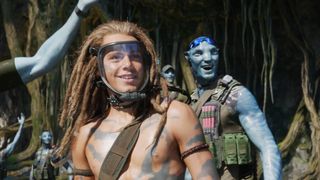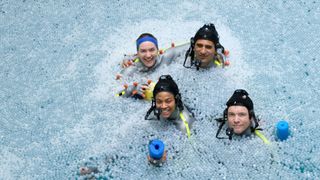Avatar 2 animators tricked James Cameron into believing some shots were practical
>
Much of Avatar: The Way of Water’s rub-your-eyes-in-disbelief magic stems from its ability to convincingly blur the practical and the digital – and the animators at Wētā FX did such a great job on that department that director James Cameron was often misled into approving entirely computer-generated shots.
In an exclusive interview with TechRadar, Daniel Barrett, Senior Animation Supervisor at the New Zealand-based visual effects company, revealed that he and his team were sometimes forced to sidestep Cameron’s desire to keep things as practical as possible in order to maximize the realism of certain shots.
“There is a lot of interaction between them [Na’vi] characters and Spider [played by Jack Champion] in The Way of Water,” explains Barrett, “and it can be a real challenge to get the kind of contact accuracy you need in a stereoscopic film. The scheduling on set was so high that many of those shots worked. But there were also times [when they didn’t].
“If you think about those shots where Quaritch carries Spider to the drop zone – that was practically all shot, but we realized pretty quickly that there were elements of Jack’s body that we had to replace with a digital one just to make sure that we could get all that contact done our digital doubles hit a really high level we had plenty of situations in the movie where we made fun of Jim [Cameron] — where he thought we were practical, and we were, in fact, digital.
“We would make the decision: what is the path of least resistance to give Jim his plate back exactly as he shot it? And sometimes the savings were too great not to go digital […] But there was clearly still a lot of work to be done. It’s a real challenge for the camera team to get match movements accurate enough to hold up in 3D movies. And they’ve done a fantastic job on this movie reconciling some of those situations for us.”
Animation 101 with Wētā FX
As someone whose team was “largely responsible for everything that moves” in The Way of Water, Barrett is one of the few people who can provide an informed answer to the question: How the hell did Cameron pull this off?
If you’ve seen any of the film’s behind-the-scenes featurettes, you’ll know that the processes involved in bringing the wholly fictional world of Pandora to life on screen must have been mind-bogglingly complex. So of course we asked Barrett to explain – in layman’s terms – how Wētā turned the likes of Kate Winslet and Cliff Curtis into 10-foot-tall, aquatic Na’vi.
“The way we broke it down,” he begins, “there were certain teams for certain sequences, but we also have specialist performers. For example, we have a face team, who did the lion’s share of the face work, and they sit as a separate department. We’ve got a motion editing team whose starting point is the performance shooting data – they’ve obviously done a ton of work on this movie. Then we have the animation team, who do a little bit of everything – they’re responsible for all the creatures, vehicles and things like that And we also have a crowds team, which deals with the larger crowd [animations], be it fish or birds or Metkayina in a village. So all those groups of people, in those divisions of what we call the movement realm, totaled about 150 at our peak.
Your facial animation will fall over if you don’t have a very accurate version of the performance.
Daniel Barrett, Wētā FX
“So the motion capture is captured – most of that was done at Lightstorm [studios] – and [the footage] is then selected by Jim, whatever he wants,” continues Barrett. “Then it will be transferred to Wētā, where it will pass through the motion capture team. Tracking is done at Lightstorm, but we like to keep track of it again to make sure we keep all the fidelity and detail of the performances. That then goes through to the motion editing team, who start working on the bodies – and that sometimes involves some cleanup work [stage]. The motion editing team – sometimes the animation team – will deal with the bits and pieces that you can’t capture,” explains Barrett, citing Na’vi fingers and tails as examples.
“We like the bodies to be pretty much done before we get to facials – and for that matter, there’s a huge amount of focus on what the head is doing because your facial animation falls over if you don’t get a very accurate version of the performance. that’s done, let’s go to facial [animations] – although sometimes when we realize we’ve missed something with the head, we have to push it back a step. And that’s pretty much the performance capture process, [with regards] to the movement team.
“Obviously there’s been an awful lot of work going on outside of us,” adds Barrett, “in terms of the models, the dressing of the characters, the shadows and the textures. But once the movement is there, the visuals by the team of creatures simulating clothes, costume and hair And then of course we have a really smart lighting team working their magic which is always so amazing To see these characters finally rendered… oh it’s just so exciting. To have worked on something that looks a little bit cartoony and then see something that looks like the real thing. It’s so much fun, such a gift.”
Judging by The Way of Water’s nearly $2 billion worldwide box office receipts, audiences are enjoying the fun too.
Avatar: The Way of Water is now playing in theaters around the world.


